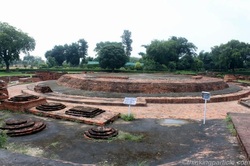 Dharmarajika Stupa Site
Dharmarajika Stupa Site “Ashes were found in a green marble box (manjusha) kept in a box of stone from Sarnath Stupa during the digging carried out by Jagat Singh, diwan of Raja Chaitsingh of Benaras in 1798.
It is believed that the ashes were immersed in river Ganga and manjusha was handed over to a museum in Kolkata,” the eastern region of Archaeological Survey of India said. Meanwhile, between 1958 and 1981, K P Jaiswal Institute in Patna started an excavation around the Stupa in Vaishali of Bihar under the supervision of A S Altekar, wherein they found another manjusha with remains of Lord Buddha, which is now kept in the Patna museum. During the British Raj, in the West-North part of Nagarjunakonda Buddh Mahachait, a coolie found a small broken pot containing the remains which were confirmed of Lord Buddha after examinations.
It is believed that the ashes were immersed in river Ganga and manjusha was handed over to a museum in Kolkata,” the eastern region of Archaeological Survey of India said. Meanwhile, between 1958 and 1981, K P Jaiswal Institute in Patna started an excavation around the Stupa in Vaishali of Bihar under the supervision of A S Altekar, wherein they found another manjusha with remains of Lord Buddha, which is now kept in the Patna museum. During the British Raj, in the West-North part of Nagarjunakonda Buddh Mahachait, a coolie found a small broken pot containing the remains which were confirmed of Lord Buddha after examinations.
The report from southern region of ASI mentions that “From 1926 to 1931, the then ASI Superintendent of southern circle A H Longhrst carried out excavation at Nagarjunakonda.” About 500 statues depicting various incidents related to Lord Buddha were found in the excavation, it said. Longhrst in one of his report’s has said remains (of Buddha) were kept in the west-north part of the stupa instead of centre so they could not be found by the treasure hunters.

 RSS Feed
RSS Feed
